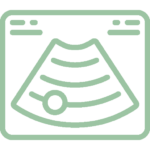Echocardiography
The function and structure of the human heart can be assessed by means of echocardiography (ultrasound examination of the heart). The examination itself can be repeated at any time without any risk or radiation exposure. Depending on where the ultrasound probe is placed, a distinction is made between trans-thoracic and trans-oesophageal echocardiography. The most important echocardiographic procedures used in the cardiology department are briefly listed below.

TRANSTHORACIC ECHOCARDIOGRAPHY
- This involves placement of the transducer on the chest
- This involves placement of the transducer on the chest
- It allows a reliable assessment of the heart’s pumping function
As well as imaging the structure of the heart valves, disorders of the heart valve function (leaks, narrowing) can be diagnosed more precisely by using Doppler procedures.
COLOUR DOPPLER ECHOCARDIOGRAPHY
- This is the colour coding of the blood flows in the heart
- It makes it possible to detect altered blood flow in the case of heart valve defects or shunts between the heart cavities
TISSUE DOPPLER IMAGING (TDI)
- This is the colour coding of the movements of the of heart muscle
- It enables a more precise analysis of wall movement disorders
- It is also used in the case of unexplained masses in the ventricles
TRANSESOPHAGEAL ECHOCARDIOGRAPHY (TEE)
- This involves the insertion of the ultrasound probe into the oesophagus (comparable to a gastroscopy)
- It enables the assessment of the smallest details of the heart structure due to the particular proximity to the heart
- It displays the smallest changes in the heart valves with a high degree of imaging accuracy
- It plays a leading role in the diagnosis of heart valve defects, cardiac inflammations, defects of the atrial or ventricular septum as well as diseases of the major blood vessels
- It is used for monitoring during and immediately after heart operations
THREE-DIMENSIONAL ECHOCARDIOGRAPHY
- This is the latest development in the field of ultrasound
- It enables a three-dimensional representation of the heart with all its structures
- It is currently used in the assessment of heart valve defects and changes in heart size and function
STRESS ECHOCARDIOGRAPHY
- This involves an exercise test under ultrasonic testing
- It is used as a complement to exercise ECGs and myocardial scintigraphy
- It enables the early localisation of functional impairment of the heart muscle in regions of insufficient blood flow
The exercise can be done on a bicycle ergometer or by infusing or injecting certain medicines. This also enables patients whose physical mobility is limited to be examined.



